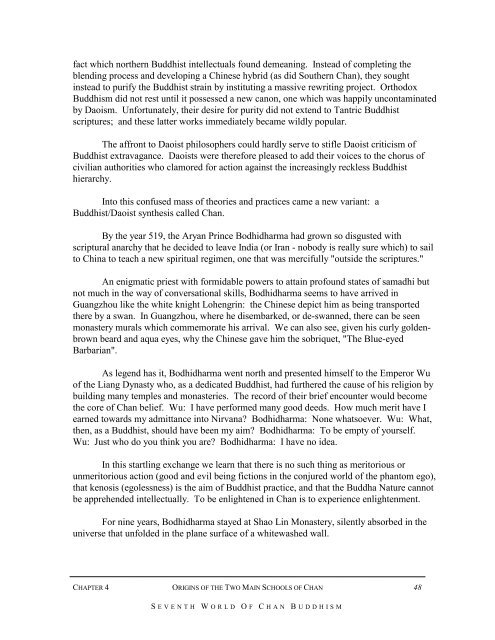seventh world of chan buddhism - Zen Buddhist Order of Hsu Yun
seventh world of chan buddhism - Zen Buddhist Order of Hsu Yun
seventh world of chan buddhism - Zen Buddhist Order of Hsu Yun
You also want an ePaper? Increase the reach of your titles
YUMPU automatically turns print PDFs into web optimized ePapers that Google loves.
fact which northern <strong>Buddhist</strong> intellectuals found demeaning. Instead <strong>of</strong> completing the<br />
blending process and developing a Chinese hybrid (as did Southern Chan), they sought<br />
instead to purify the <strong>Buddhist</strong> strain by instituting a massive rewriting project. Orthodox<br />
Buddhism did not rest until it possessed a new canon, one which was happily uncontaminated<br />
by Daoism. Unfortunately, their desire for purity did not extend to Tantric <strong>Buddhist</strong><br />
scriptures; and these latter works immediately became wildly popular.<br />
The affront to Daoist philosophers could hardly serve to stifle Daoist criticism <strong>of</strong><br />
<strong>Buddhist</strong> extravagance. Daoists were therefore pleased to add their voices to the chorus <strong>of</strong><br />
civilian authorities who clamored for action against the increasingly reckless <strong>Buddhist</strong><br />
hierarchy.<br />
Into this confused mass <strong>of</strong> theories and practices came a new variant: a<br />
<strong>Buddhist</strong>/Daoist synthesis called Chan.<br />
By the year 519, the Aryan Prince Bodhidharma had grown so disgusted with<br />
scriptural anarchy that he decided to leave India (or Iran - nobody is really sure which) to sail<br />
to China to teach a new spiritual regimen, one that was mercifully "outside the scriptures."<br />
An enigmatic priest with formidable powers to attain pr<strong>of</strong>ound states <strong>of</strong> samadhi but<br />
not much in the way <strong>of</strong> conversational skills, Bodhidharma seems to have arrived in<br />
Guangzhou like the white knight Lohengrin: the Chinese depict him as being transported<br />
there by a swan. In Guangzhou, where he disembarked, or de-swanned, there can be seen<br />
monastery murals which commemorate his arrival. We can also see, given his curly goldenbrown<br />
beard and aqua eyes, why the Chinese gave him the sobriquet, "The Blue-eyed<br />
Barbarian".<br />
As legend has it, Bodhidharma went north and presented himself to the Emperor Wu<br />
<strong>of</strong> the Liang Dynasty who, as a dedicated <strong>Buddhist</strong>, had furthered the cause <strong>of</strong> his religion by<br />
building many temples and monasteries. The record <strong>of</strong> their brief encounter would become<br />
the core <strong>of</strong> Chan belief. Wu: I have performed many good deeds. How much merit have I<br />
earned towards my admittance into Nirvana? Bodhidharma: None whatsoever. Wu: What,<br />
then, as a <strong>Buddhist</strong>, should have been my aim? Bodhidharma: To be empty <strong>of</strong> yourself.<br />
Wu: Just who do you think you are? Bodhidharma: I have no idea.<br />
In this startling ex<strong>chan</strong>ge we learn that there is no such thing as meritorious or<br />
unmeritorious action (good and evil being fictions in the conjured <strong>world</strong> <strong>of</strong> the phantom ego),<br />
that kenosis (egolessness) is the aim <strong>of</strong> <strong>Buddhist</strong> practice, and that the Buddha Nature cannot<br />
be apprehended intellectually. To be enlightened in Chan is to experience enlightenment.<br />
For nine years, Bodhidharma stayed at Shao Lin Monastery, silently absorbed in the<br />
universe that unfolded in the plane surface <strong>of</strong> a whitewashed wall.<br />
CHAPTER 4 ORIGINS OF THE TWO MAIN SCHOOLS OF CHAN<br />
S EVENTH W ORLD O F C HAN B UDDHISM<br />
48


